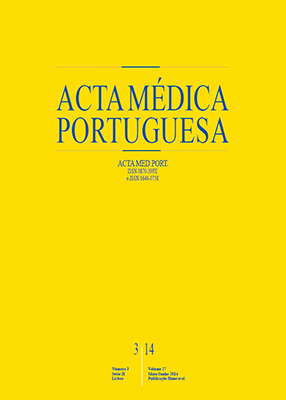Allergic Contact Dermatitis to Metals over a 20-Year Period in the Centre of Portugal: Evaluation of the Effects of the European Directives
DOI:
https://doi.org/10.20344/amp.4112Abstract
Introduction: Metals are a common cause of allergic contact dermatitis. After the introduction of the EU Nickel Directive (1994/27/CE; 2004/96/EC) and, more recently, the Cement Directive (2003/53/EC) there has been a significant decrease in sensitization to metals mainly in the Nordic countries. The applicability of these directives and their impact in the Portuguese population is unknown.Material and Methods: A retrospective study (1992-2011) was carried out in our patch test clinic to assess the temporal trend of metal sensitization (nickel [Ni], cobalt [Co] and chromium [Cr]) along the last 20 years, particularly considering age, sex and its relation with occupational activity.
Results: Out of 5 250 consecutively patch-tested patients, 1 626 (31%) were reactive to at least one metal (26.5% to Ni; 10.0% to Co and 7.9% to Cr). Women had a higher prevalence of sensitization to Ni (34.4% vs 8.9%) whereas men were more reactive to Cr (11.5% vs 5.0%). Nickel sensitization did not decrease significantly over the years, although in recent years among women sensitized to nickel the percentage of younger patients (16-30 years-old) is significantly lower (p < 0.001). Chromium sensitization significantly decreased, particularly in men (r = -0.535), and mainly in the construction workers (r = -0.639). Chromium reactivity associated with the shoe dermatitis has remained stable.
Discussion: We emphasize the higher and stable percentage of nickel sensitized individuals suggesting, so far, a low impact from the EU Ni directive, although a decreasing percentage in the the younger group among Ni sensitized women may suggest a beneficial effect is becoming evident is this age group. On the contrary, the impact of the directive regarding the modification of Cr in cement seems to be effective. There is now a need to regulate chromium content in leather products, namely in shoes.
Conclusions: The regulation of interventional measures related either to the manufacture and trade of adornments or professional use will better protect the population of allergy to metals.
Keywords: Dermatitis, Allergic Contact; Chromium; Cobalt; European Union; Metals; Nickel; Patch Tests; Portugal.
Downloads
Downloads
Published
How to Cite
Issue
Section
License
All the articles published in the AMP are open access and comply with the requirements of funding agencies or academic institutions. The AMP is governed by the terms of the Creative Commons ‘Attribution – Non-Commercial Use - (CC-BY-NC)’ license, regarding the use by third parties.
It is the author’s responsibility to obtain approval for the reproduction of figures, tables, etc. from other publications.
Upon acceptance of an article for publication, the authors will be asked to complete the ICMJE “Copyright Liability and Copyright Sharing Statement “(http://www.actamedicaportuguesa.com/info/AMP-NormasPublicacao.pdf) and the “Declaration of Potential Conflicts of Interest” (http:// www.icmje.org/conflicts-of-interest). An e-mail will be sent to the corresponding author to acknowledge receipt of the manuscript.
After publication, the authors are authorised to make their articles available in repositories of their institutions of origin, as long as they always mention where they were published and according to the Creative Commons license.









